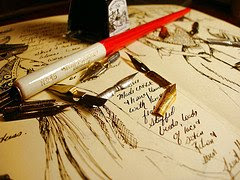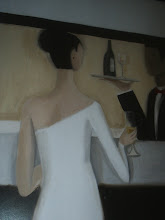


As a child from a military family, how has this added / taken away to your artistic inspiration?
The military background leads to a lot of moving for a family, usually at critical times for young children and teenagers. It was difficult to have long-term friendships. I feel that led to a lot of self-sufficiency and solitude on my part. The art obsession was always there; those conditions just allowed it to play a larger role.
Tell us the history behind your artistic growth from realistic portrayals of nature and wildlife, moving to on realism and portraiture, stained glass, only to begin the circle again with the love of painting.
I was always interested in capturing a memory or feeling with imagery. Often, the source came from books I had read or things I had experienced. Portraiture is the ultimate test, because capturing a likeness combines so many things: accuracy, rendering, yet somehow you are also adding something that isn't there - your feelings about what you are painting. Animals and places are actually individuals too, but this is a more esoteric concept for some. I feel that every artist must first develop solid drawing skills. From there anything is possible. Even abstraction becomes informed. I see my tour through various art media as an unwitting enactment of those steps. I didn't set out with any conscious plan to develop myself, but the frustration that came from not being able to capture something led naturally to it. It is an ongoing process that is never complete.
What is your role as an artist?
I feel my role as an artist is to keep the arts alive in a world that is becoming faster and more hurried by the day. Many people come into a booth where my paintings are displayed and I can see their shoulders relax as they begin to smile. Some just look peaceful. It is a great feeling. So maybe I what I do is connect them with a lost part of themselves or their past.
What special message is found in your creations?
I don't think there is a message that applies to everyone. In some pieces, like "Lucky Foot", I am trying to say something specific, but not as a rule. I have noticed that there are many different connections to the same painting. All of them seem to be about feelings or memories.
What is the challenge of revealing the “art” in Earth?
The challenge is to remind people that it is there.
Explain the statement “Earth's natural wonders. Now, more than ever, they are in need of our attention.”
Our lives are very busy, and we often forget to stop and take a breath. A lot of us are disconnected from the things that a natural environment for us, trees, fresh air, small animals. There is a need to take a look at all of it before it is all gone. I am hoping that everyone that sees my paintings will take a bit of that feeling away and apply that energy somewhere in a positive way.
Where can readers find your works?
Readers can find my works on my website at http://www.theartinearth.com/, in the homes of select collectors and at venues I attend every year, like the Buckhorn Fine Art Festival, which is one of the finest art shows in Canada. I will be updating my website regularly to announce new showings.
Can you describe the process you go through when creating a piece from start to finish?
I am an avid cyclist, so usually things begin with a ride through the countryside. This gives me the inspiration for all of my landscapes and most of my bird paintings. For the more exotic animals, I go to the zoo, or to wildlife rehabilitation centres. Then, I take all the pictures back and peruse them on the computer. Usually, I work from printouts of digital photos, combining several at a time as I go along. Sometimes, I do some editing in Photoshop to remove distracting elements and combine them there. I work on Masonite, which I cut and prepare myself, usually in large batches. (It would be terrible to have inspiration and nothing to paint it on!) I almost never do any preliminary sketches because I prefer to immerse myself immediately, although sometimes I will do a study of something in an 8x10 format to get the idea. For more complex pieces, I may build the image up in pencil first, but lately I have been forcing myself to be more painterly and work the sketch up with a brush. Once I am going on a piece, I don't usually divert my attention to anything else until it is done. Most of my larger paintings take couple of weeks to a month to complete, but lately I have been having great fun with quick 8x10 colour studies of the Southern Ontario farmland that I see from my bike.
What do you want to be remembered for?
Can you describe the process you go through when creating a piece from start to finish?
I am an avid cyclist, so usually things begin with a ride through the countryside. This gives me the inspiration for all of my landscapes and most of my bird paintings. For the more exotic animals, I go to the zoo, or to wildlife rehabilitation centres. Then, I take all the pictures back and peruse them on the computer. Usually, I work from printouts of digital photos, combining several at a time as I go along. Sometimes, I do some editing in Photoshop to remove distracting elements and combine them there. I work on Masonite, which I cut and prepare myself, usually in large batches. (It would be terrible to have inspiration and nothing to paint it on!) I almost never do any preliminary sketches because I prefer to immerse myself immediately, although sometimes I will do a study of something in an 8x10 format to get the idea. For more complex pieces, I may build the image up in pencil first, but lately I have been forcing myself to be more painterly and work the sketch up with a brush. Once I am going on a piece, I don't usually divert my attention to anything else until it is done. Most of my larger paintings take couple of weeks to a month to complete, but lately I have been having great fun with quick 8x10 colour studies of the Southern Ontario farmland that I see from my bike.
What do you want to be remembered for?
Hmm.. That is a tough question.... I guess to answer it, I would look to people I admire. I admire people with energy and the ability to inspire others. For instance, there are some teachers I had in high school that made me want to work really hard to meet their standards. So I guess it would-be something like that. Oh and also great paintings.
How would you describe yourself?
I would describe myself as high energy with a tendency toward impatience (for some things). I appreciate fairness and honesty and hope to think I give it back. (I can also work tirelessly on a painting --mostly the ones that I secretly know will never amount to anything.)
What do you hope people think of when they view your work?
I hope that it will connect them with something good that they have misplaced in their lives -- or that they have limited access to for some reason. One of my friends has a tiny reproduction of a woman sitting by a waterside cottage at dusk. It makes her feel good to look at it when she is having a hard time. It would make me feel great if my work could do that for people.
Is there anything else you’d like our readers to know about? The artist:--the woman
I am I think I will answer that with a quote (out of context) from wildlife artist George McLean, whom I really admire:
"Everything that could be said is in the painting(s)"
How would you describe yourself?
I would describe myself as high energy with a tendency toward impatience (for some things). I appreciate fairness and honesty and hope to think I give it back. (I can also work tirelessly on a painting --mostly the ones that I secretly know will never amount to anything.)
What do you hope people think of when they view your work?
I hope that it will connect them with something good that they have misplaced in their lives -- or that they have limited access to for some reason. One of my friends has a tiny reproduction of a woman sitting by a waterside cottage at dusk. It makes her feel good to look at it when she is having a hard time. It would make me feel great if my work could do that for people.
Is there anything else you’d like our readers to know about? The artist:--the woman
I am I think I will answer that with a quote (out of context) from wildlife artist George McLean, whom I really admire:
"Everything that could be said is in the painting(s)"


